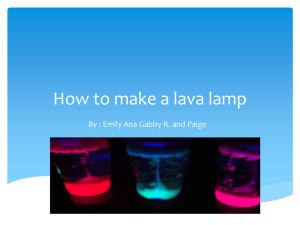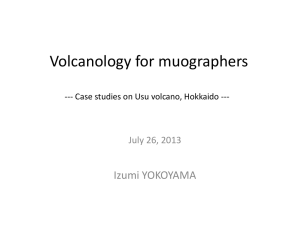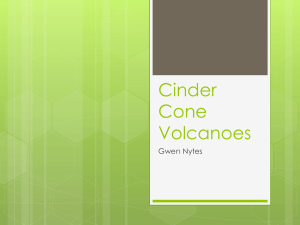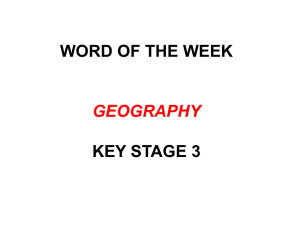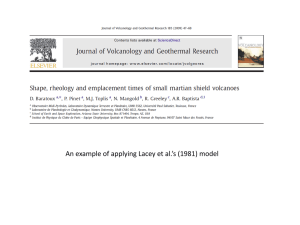Lava textures
advertisement
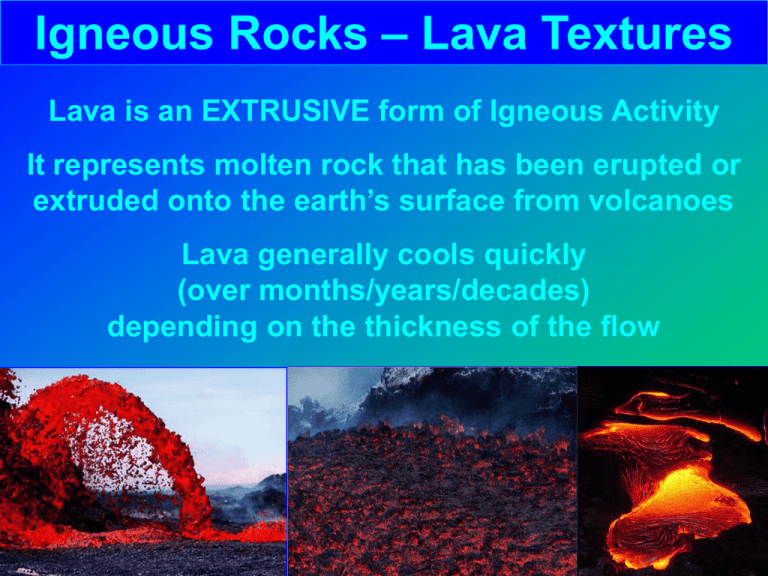
Igneous Rocks – Lava Textures Lava is an EXTRUSIVE form of Igneous Activity It represents molten rock that has been erupted or extruded onto the earth’s surface from volcanoes Lava generally cools quickly (over months/years/decades) depending on the thickness of the flow Igneous Rocks – Lava Textures The rate of cooling determines crystal size Lavas erupted onto the Earth’s surface cool relatively rapidly resulting in crystals less than 0.5mm in diameter Igneous rocks with crystals <0.5mm in diameter are termed VOLCANIC Types of Lava Basalt - Hawaii Andesite – Mount St. Helens Rhyolite - Yellowstone Pumice – Jemez Mts. Mexico Lava Textures - Pillow Lavas Formed by submarine eruptions of basaltic magma whereby the exterior chills and crystallises rapidly against cold seawater at around 5°C The outside layer will have a glassy texture with vesicles (gas bubbles) trapped below the surface Lava Textures – Glassy Formed by instantaneous cooling of lava so that there is no time for crystals to form The structure is very similar to glass and shows good conchoidal fracture when broken with a hammer 1cm Lava Textures - Pahoehoe Similar to skin on custard! As the external layer cools and solidifies it forms a rope-like pattern of rock as the liquid lava continues to move underneath. Lava Textures - aa Aa lava has a surface made of sharp, angular and jagged blocks of basalt. The cooled surface layer breaks up into these fragments as molten lava continues to flow beneath Lava Flows-Typical Structure Baked Margin Lava flows typically have rubbly bases and tops (Sometimes showing pahoehoe or aa texture). The interior often shows columnar jointing and vesicles are often trapped in the upper part of the flow. The ground underneath the lava will be baked from the heat showing a zone of contact metamorphism (baked margin) Lava Flows- Lava Tubes Lava tubes are sub-surface tunnels within lava flows that have been formed as the fluid lava has continued to flow down slope. The solid top and base is formed as it cools and solidifies against the ground and the atmosphere Lava Textures - Vesicular 1cm The holes (or vesicles) in this rock represent gas bubbles that were trapped in the lava as it cooled and solidified. Lava Textures – Vesicular/Pumice 1cm This is a specimen of highly vesicular rhyolite (an acid lava flow) which is more commonly known as pumice. It is so light it actually floats on water. Also used to remove rough skin! Lava Textures - Amygdaloidal 1cm The holes (or vesicles) in this rock represent gas bubbles that were trapped in the lava as it cooled and solidified. Later mineral rich waters percolated through the rock and deposited quartz (agate in this case) from solution Flood Basalts-Mega Eruptions of Lava These are basaltic eruptions that last between 0.5 and 2 million years and have a global impact on climate and life. The mountains above are part of the Deccan Trapps in India which were formed about 65 Ma. At this time enough basalt was extruded to cover the whole of the USA to a depth of 1km It resulted in 75% of life on earth becoming extinct including the dinosaurs and ammonites. Lava Textures – Columnar Jointing Columnar jointing forms when thick lava flows (tens of metres) cool slowly. As the lava cools discrete cooling centres develop and the rock contracts towards these centres producing a polygonal pattern of vertical joints. Lava Textures – Columnar Jointing Columnar jointing produces columns of basalt with anything from 4 to seven sides. The base and top of flows are often rubbly as they have chilled against the ground and the air. Lava Textures – Columnar Jointing The album sleeve for Led Zeppelin’s ‘Houses of the Holy’ was shot at The Giant’s Causeway in Northern Ireland. It depicts naked ladies clambering over the polygonal basalt columns Yet another example of why Geology Rocks! The End

